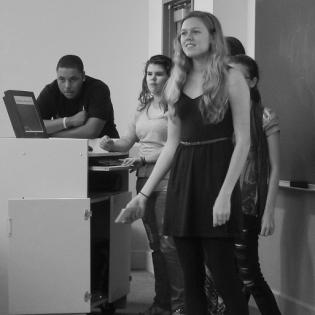Exercise and Good Health
Students research the practices of healthy exercise. They identify a topic related to good nutrition and personal health and write 3-5 facts to share with the class. They identify nonprofits that work to address related health needs and contact them by phone to ask questions.
Learners will:
- match their age and lifestyle with appropriate exercises and set goals.
- conduct research on a self-selected topic related to health.
- share 3-5 facts from their research.
- Internet access
- books about exercise and nutrition; local guidelines for appropriate exercise for youth
- optional: guest expert on exercise and nutrition to be interviewed
Instructions
Anticipatory Set: Name an athlete in the recent media, such as Simone Biles or Mia Hamm who is very healthy and respected. Discuss this person's habits, attitude, and qualities that could include generosity, routine, practice, teamwork, and self-improvement. If possible, look at video and quotes from this person. Ask students to reflect on what they admire about this athlete or another. While we might not be at their athletic ability level, what can we learn from the athlete for our own best practice?
Do this cooperative activity: Human Knot. Afterward, reflect on what they were thinking (self talk) that helped them do well and group practices (listening, patience) that helped them untangle successfully.
Identify a good rule for how much exercise to get each week, and what types. Use a local resource or school recommendation for their age. For example, get 50 minutes of exercise four times a week; two sessions should be cardio, one should build muscle, and one should include stretching and stengthening (yoga). Write the expectations on the board and brainstorm examples of each type of exercise for fitness and fun. This may be sports, games, or fitness activities.
Talk about the physical, general health, and mental benefits of regular exercise.
Have a discussion about the barriers and motivations to keep a routine exercise schedule. For example, Miguel runs while watching a suspenseful TV series. He only allows himself to watch an episode while on the treadmill. It motivates him to come back. Li rides her bike with her friend Christina to keep them both interested. Kyle is on a baseball team. Frieda says her overthinking keeps her from getting started, so when she starts making excuses, she tells herself she's "doing that again" and pushes the negative thoughts away.
For homework, each student picks a subtopic about health and finds 3-5 facts about their topic (through online research, a book, or an interview with an expert) to share with the class during the next session. They record their facts on a clearly labeled "poster" (you provide paper of a consistent size). They must include their sources and write neatly and with accurate spelling. The posters will be displayed and discussed in the next session.
Brainstorm areas for their topics, such as the following:
- sleep and health
- specific diets
- diseases and cancer
- mental health
- food insecurity
- exercise habits
- appropriate running distances for teens
- drinking water
Session Two
Have students display around the room their posters with 3-5 facts. They do a gallery walk and read each person's facts, taking notes about which facts interest them or raise more questions.
- After sufficient time to read all the posters, come back together and discuss what they found interesting. Ask what they would like to know more about, and follow their interests to learn more.
- Ask whether they think their community knows these facts and follows good healthy habits? Discuss.
Ask, "Do you think our school and our neighborhood support healthy living? Why or why not?" Tell the students that they are going to investigate the health of the community. They may look on the internet, in local newspapers, interview experts, take a survey, or observe the community on a walk or family drive. Make a plan together for how each student will gather information and what they are looking for. Here are some questions to get started:
How available is farm-fresh food? How many sites are nearby?
How affordable is fresh food compared to canned or packaged food?
Where is junk food available in and near the school or your house?
What places around the school or community make exercise fun and easy to access?
After gathering information and talking about the findings, ask, "What do you think are the most urgent health needs in our school and the neighborhood?"Say, "Let's find out what nonprofit organizations support these health needs in the community. Discuss the difference between a nonprofit, a business, and a government agency. An example of a nonprofit that helps people who are hungry get food is Feeding America.
Put students in groups by their interest areas to search on the Internet to find local places that address some of the questions they have.
Each group will contact a local nonprofit (or several) to find out more about what they do and what their needs are. (How can we help?) Before they make phone calls, they should prepare a script for what they want to say about who they are and ask about the nonprofit.
Note: Depending on the students' experience, you may do some coaching and practicing about speaking clearly, how to introduce themselves, and what to ask.
Each group writes a summary of their interest area, their question about community health, who they contacted, and what they learned about the services and the needs of the organization.
Play a physical game for fun and fitness. This game "Rock, Paper, Scissors War" provides one idea.
Philanthropy Framework
-
Strand PHIL.IV Volunteering and Service
-
Standard VS 01. Needs Assessment
-
Benchmark HS.1 Identify a need in the school, local community, state, nation, or world.
-
Benchmark HS.2 Research the need in the school, neighborhood, local community, state, nation, or world.
-
-
